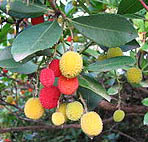
Native to the Mediterranean region and western Europe, this broadleaf evergreen shrub or small tree is a member of the heather family, Ericaceae, that also includes rhododendron, blueberry, and mountain laurel. It grows up to 33′ tall and has spreading limbs with exfoliating gray-brown bark that reveals the reddish bark below. As the plant matures the limbs and trunk become gnarled and add an architectural element to the garden. The dark green leaves are glossy, leathery, and are two to four inches long. The white to pink urn-shaped flowers are fragrant and produced in clusters in the fall. Each cluster is two inches long and composed of ten to thirty flowers. The strawberry-like fruits develop over the course of the following year and are ripe in the fall about the same time new flowers are being produced. The berries are enjoyed by birds, can be made into jams and liqueurs, and are valued for their use in flower arrangements especially when used with other fruits. The flowers and leaves, however, are not good plant material for the vase. The genus name, Arbutus, is from the Latin word arbor meaning tree. The ancient naturalist Pliny the Elder is said to have created the specific epithet, unedo, from the Latin words unum meaning one, and edo, meaning I eat, perhaps referring to the blandness of the fruit.
Type: Broadleaf evergreen shrub or small tree.
Outstanding Feature: White flowers and yellow or red strawberry-like fruits in fall; cinnamon-red new bark revealed by exfoliating older bark.
Form: Vase.
Growth Rate: Slow.
Bloom: Small white bell-shaped flowers borne in panicles in fall.
Size: 16-33’ H x 16-33’ W
Light: Full sun to part shade except in dessert areas where it tolerates more shade.
Soil: Well drained, limey soil.
Water: Naturally adapted to dry summers; water moderately.
Hardiness: Zones 8-10.
Care: Low maintenance; plant in sheltered site; drought tolerant when established but may need watering when newly planted.
Pests and Diseases: Susceptible to scales, thrips, anthracnose, phytophthora, root rot, and rust.
Propagation: Seeds with cold stratification; semi-ripe cuttings in summer or autumn, layering
Outstanding Selections:
‘Atlantic’
‘Compacta’ (10 feet tall). ‘Atlantic’
‘Elfin King’ (5 feet tall, flowers and fruits almost continuously)
‘Oktoberfest’ (6-8 feet tall with deep pink flowers)
Photo Credit: Wikipedia